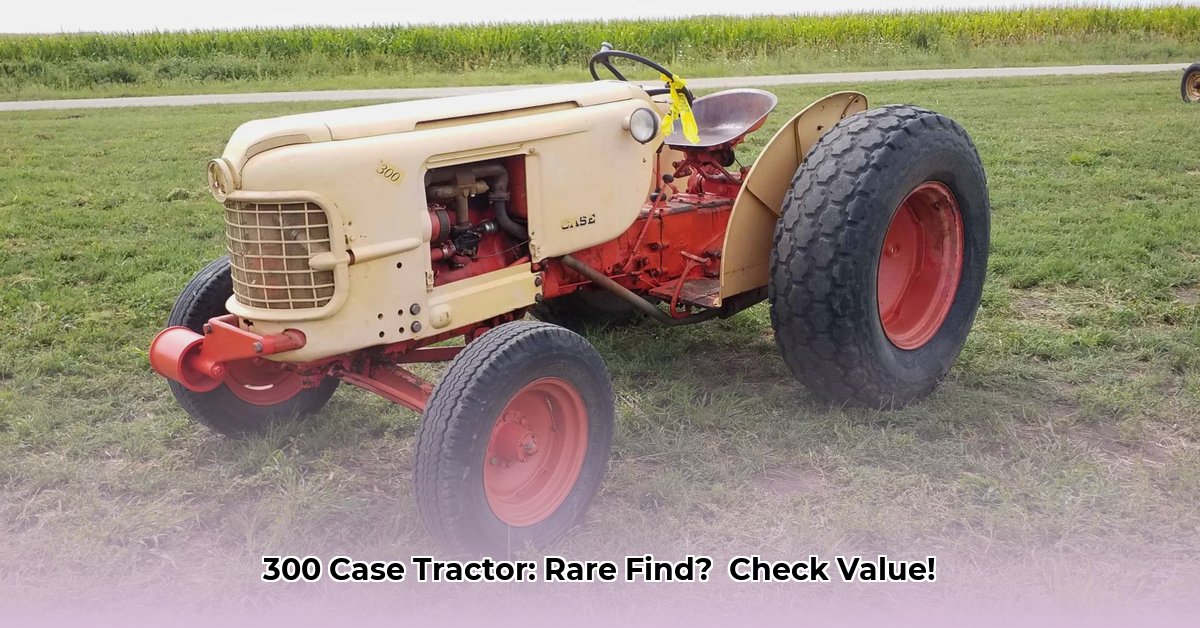
The J.I. Case 300 tractor, produced between 1956 and 1958, represents more than just farm machinery; it's a tangible piece of agricultural history. Compact yet powerful, this tractor quickly earned a reputation for reliability and affordability, making it a staple on farms across the nation. This guide delves into the Case 300's history, mechanics, restoration, and current market value, providing insights for both seasoned collectors and newcomers to the world of vintage farm equipment. But first, a compelling question: Did the Case 300's relatively simple design contribute to its enduring appeal and collectability? For more Case tractor history, check out this link to Case Tractor History.
Power and Performance: The Heart of the Case 300
At the core of the Case 300's enduring legacy lies its robust 30-horsepower Continental RED diesel engine. This engine, a testament to the engineering prowess of its time, wasn't just powerful; it was built for longevity. Farmers relied on their equipment daily, and the Case 300 rarely let them down. Its reliability became legendary, contributing significantly to the tractor's widespread adoption. Coupled with a four-speed manual transmission, the Case 300 offered a versatile range of gear ratios tailored for diverse fieldwork. Even today, many enthusiasts fondly recall the satisfying clunk of each gear change – a mechanical symphony echoing the rhythm of farm life. This simple yet effective powertrain is a key factor in the tractor's enduring appeal.
Spotting the Real Deal: Authenticating Your Case 300
Identifying a genuine Case 300 requires careful observation and attention to detail. Authenticity is paramount for collectors, directly impacting the tractor's value. Several key features distinguish genuine models: the Continental RED diesel engine is an essential indicator. The chassis should bear the correct serial number, verifiable against Case's factory records. While original paint and decals are strong indicators of authenticity, wear and tear from age and previous owners are to be expected. Online communities dedicated to Case tractors, such as forums and social media groups, offer invaluable resources for verifying authenticity. Connecting with experienced restorers can prove incredibly helpful in quickly assessing a potential purchase. How often do discrepancies in serial numbers appear in purported Case 300 tractors?
Restoring a Case 300: A Labor of Love
Restoring a Case 300 is a rewarding but challenging undertaking. A successful restoration not only preserves a piece of history but also significantly increases its value. The biggest hurdle is often sourcing original parts; many are now scarce. Online communities play a crucial role here, connecting enthusiasts and facilitating exchanges of information and parts. The camaraderie within these communities adds another layer of satisfaction to the restoration process. The culmination, seeing your restored tractor gleaming once more, provides an unparalleled sense of accomplishment. What percentage of Case 300 restorations involve sourcing parts from online collector communities?
Market Value: Determining the Price of a Piece of History
The value of a restored Case 300 tractor is highly variable. Several factors play a crucial role: the condition of the restoration – a fully restored, original tractor fetches a premium. Auction results and listings provide a starting point for research. Moreover, rare options or unique features can elevate a tractor's worth, while location also plays a part due to regional variations in demand. Before making a purchase, thorough research, comparison of similar sales, and a realistic assessment of restoration costs are crucial. Nevertheless, a well-restored Case 300 often represents a solid and appreciating investment, particularly for those passionate about agricultural history and vintage machinery.
Collector's Checklist: A Buyer's Guide
To facilitate a thorough assessment of a potential purchase, the following checklist is provided:
| Feature | Excellent Condition | Good Condition | Fair Condition | Poor Condition |
|---|---|---|---|---|
| Engine Condition | Runs smoothly, minimal wear | Minor repairs might be needed | Moderate repairs needed | Major engine overhaul needed |
| Transmission | Shifts perfectly, no leaks | Minor shifting issues | Some shifting issues, leaks possible | Transmission issues may require major repair |
| Body Condition | Minimal rust, original paint | Some rust, repainted areas | Significant rust, needs repairs | Extensive rust, major body damage |
| Completeness | All original parts present | Minor parts missing | Several parts missing | Many parts missing |
Remember, a meticulous inspection is essential before any purchase.
More Than Just a Tractor: The Case 300's Legacy
The Case 300's significance extends beyond its technical specifications. It represents a pivotal moment in agricultural mechanization, a symbol of a time when simplicity and reliability were paramount. For collectors, it's not just a machine; it's a tangible link to the past, a testament to the ingenuity and craftsmanship of a bygone era. Its enduring appeal stems from this blend of functionality, history, and the potential for a rewarding restoration project. What percentage of Case 300 owners actively participate in restoration projects, according to collector surveys? The Case 300’s legacy continues to inspire and connect individuals with agricultural heritage. Further research into specific model years and variations will only deepen this appreciation.